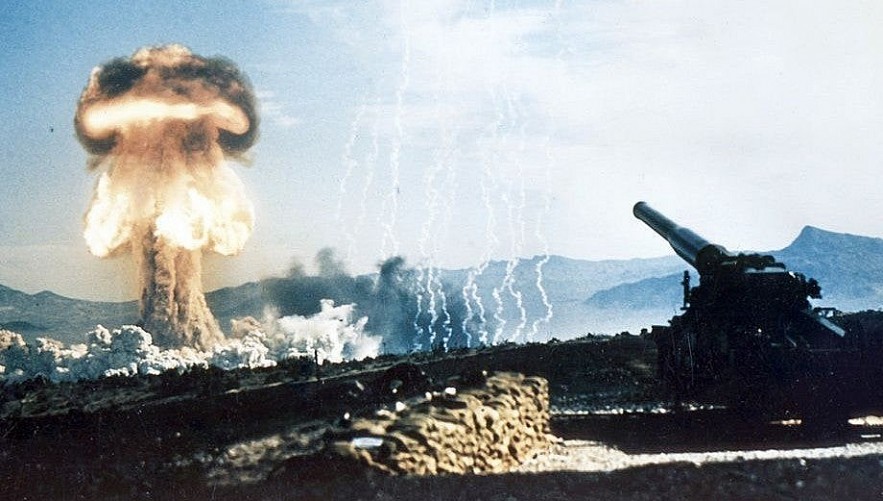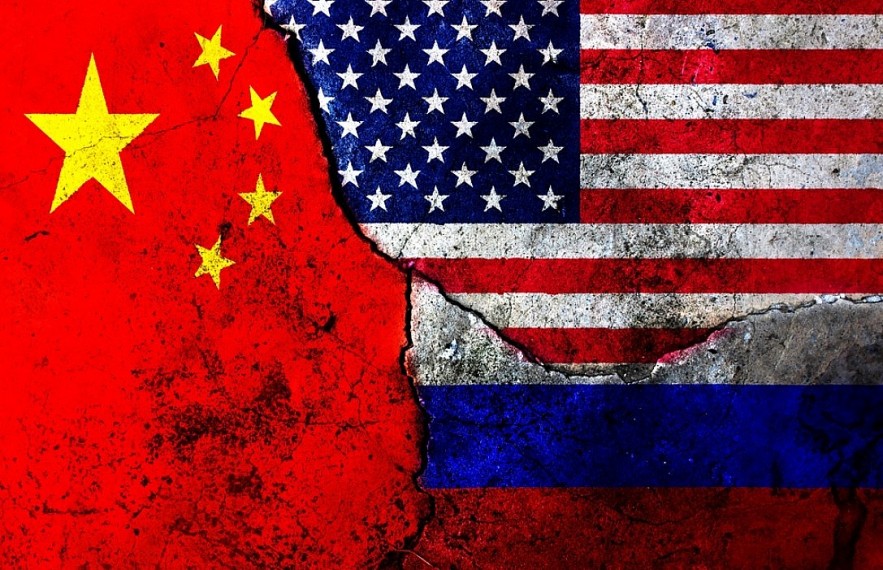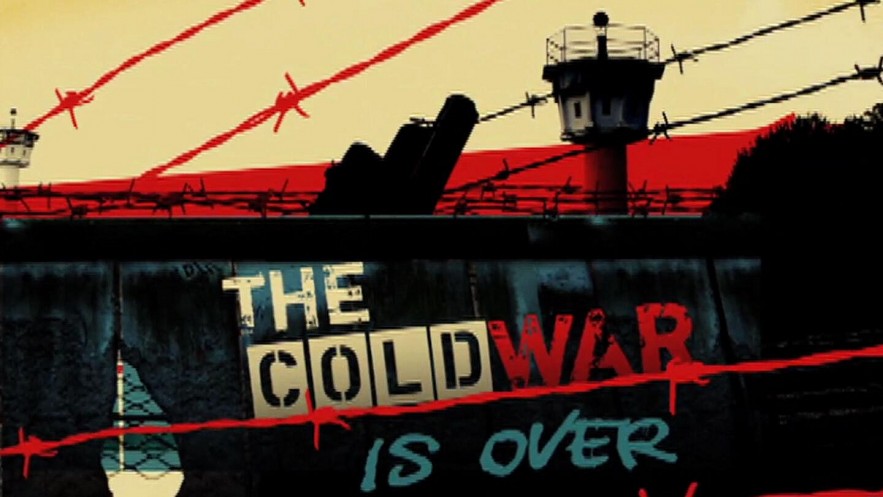What is the Cold War: Causes, Purpose and Will There be More World War?
♦ What Happened to the 15 Republics in the Former Soviet Union (USSR)
 |
| What is the Cold War |
| Contents |
Cold War is a phrase that is quite common in today's life. Usually, when there is a conflict, the two sides do not directly reconcile and there is no quarrel, but both are silent to put pressure on the other, it is a simple form of "war". cold".
The Cold War is actually a tense war between two superpower empires, the United States and the Soviet Union, in the mid-20th century.
So what is the cold war? What are the causes, nature, developments, purposes and consequences of the cold war? And people wonder if there will be more cold war in the world?
What is the Cold War and Origins?
The Cold War was a “war” that took place from 1947 to 1991. The Cold War was the climax of political confrontation and ideological conflict between two superpowers, the United States (capitalism). version) and the Soviet Union (socialism).
Historians say that the Cold War began in 1947 with the so-called Truman Doctrine - a program of "restraint" aimed at America's arch-enemy at the time, the Soviet Union, the war that started it. on the recommendation of American diplomat George Kennan and lasted until December 26, 1991, when the Soviet Union officially dissolved.
However, according to another opinion, the Cold War really began in 1945 when the US dropped two atomic bombs on the Japanese cities of Hiroshima and Nagasaki in the last days of World War II.
It was this action that caused the negative indignation of the Japanese people in particular and the world in general. The Soviet Union at that time could not turn a blind eye to the abuse of the US military, and it was the fearsome act of dropping nuclear bombs on Japan - which surprised both the Soviet Union and the world, boosting its leadership. Soviet leader Joseph Stalin accelerated the Soviet nuclear program.
On August 29, 1949, the Soviet Union successfully tested its first nuclear weapon, thereby achieving a strategic balance and putting pressure on the United States. The successful Soviet test was a blow to the US military, not only helping the Soviet Union strengthen its position on the world military battlefield, but also a push for the US to increase its military force.
For millions of people around the world, this was the beginning of the Cold War – a veritable nightmare in which two nuclear-armed superpowers became entangled in an ideological battle.
In addition, although the forces participating in the cold war mainly never entered a conflict, by inciting its allies to cause trouble like the way the United States did, this is an indirect way. when they have demonstrated their conflict through military alliances.
The United States and the Soviet Union carried out strategic conventional force deployments and aggressively conducted military buildups, nuclear arms races, intelligence, and proxy wars. Beyond that, there's also the technical competition and the space race. Thus, it can be said that the cold war is an indirect confrontation by means of an arms race between two factions: capitalism and socialism.
| In the United States, as in the Soviet Union, almost all students participated in emergency drills to prepare for the terrible things that could happen as a result of nuclear war. |
Causes of the Cold War
During World War II, the US and the Soviet Union fought each other as allies against the Fascist countries.
However, US-Soviet relations were quite tense. Americans had long been wary of Soviet communism and worried about Soviet leader Joseph Stalin.
For its part, the Soviets resented the fact that for decades the Americans did not treat the Soviet Union as a legitimate part of the international community and that they were mired in a World War II that led to their death. of tens of millions of Russians.
After the war ended, this grievance ripened into a feeling of mutual overwhelmingness and mutual hatred. The Soviets became resentful of what they perceived as mere rhetoric by US officials about weapons development and Washington's involvement in international relations. In such an atmosphere of hostility, the Cold War was inevitable.
The Cold War is defined as the period of political and military confrontation between the United States and the Soviet Union after the end of World War II.
The "war" element here shows the big difference in power and ideology between the two countries; while "cold" reflects the fact that the Soviet Union and the United States did not use "hot" weapons (conventional weapons) for this hostile relationship, but instead a prominent arms race. are nuclear weapons.
In fact, the Cold War was the last stage in the history of the bipolar system when both the United States and the Soviet Union were symbols; and the conflict between the two countries is also characterized by the conflict between the capitalist faction (led by the United States) and the socialist faction (led by the Soviet Union).
The Cold War also had a profound impact on almost every aspect of the political, economic, cultural and social life of each country as each country chose its development path based on the determination of its own intentions. system.
In short, the Soviet Union advocated maintaining world peace and security, protecting the achievements of socialism and promoting the world revolutionary movement.
Meanwhile, the US tried to destroy the Soviet Union and the socialist countries, repel the revolutionary movement in order to carry out the plot of world hegemony.
Socialism has become the world system and is expanding into Asia and Latin America, causing socialism to extend from Europe to Asia and Latin America, the influence of the Soviet Union and socialism in general. widening. In this context, the United States sought to prevent this influence of socialism. After the Second World War, the United States became the richest and most powerful country in terms of economy, finance, military, and was holding the advantage of nuclear weapons.
Since then, the US has given itself the right to lead the world, against socialism. In the context of the post-war world, the Soviet Union and the United States moved from war cooperation to confrontation and the Cold War.
Evolution and Nature of the Cold War
The evolution of the cold war was relatively complicated. Whether allied against the Axis, the United States, the Soviet Union, Great Britain or France disagreed after World War II and especially on the issue of post-war world setting.
Thus, when the cold war ended, they quickly occupied most of Europe with the United States and the Soviet Union forming the two most powerful military forces.
In addition, the Soviet Union created the Eastern European bloc with the countries it had liberated after the cold war. At the same time, carry out the merger of some countries to become Soviet Socialist Republics and still maintain the activities of other countries as their allies.
 |
| Cold War |
The United States, along with a number of Western European countries, coordinated to set up policies to prevent communism and typically defensive policies, creating the NATO alliance (1949) to serve its purposes. . The birth of NATO forced the Soviet Union to think about forming a military alliance of its own. On May 14, 1955, the Soviet Union established the Warsaw Pact Organization.
In addition, many of these countries participated in the reconstruction of Europe and especially West Germany, which was opposed by the Soviet Union. Besides, in many other places such as Latin America and Southeast Asia, the Soviet Union strongly supported the revolutionary struggles for national liberation, in which the national liberation struggles were won as in Vietnam. Male. In contrast, many Western countries supported anti-colonialism. The rest, a number of countries have found ways to lower and quickly extinguish the movement for national independence.
The distinguishing feature of this war is that there are periods of relative calm but also periods of high tension in international relations. Among them are prominent such as the Berlin blockade (1948-1949), the Korean War (1950-1953) or the 1961 Berlin crisis, the Indochina war (1945-1975) and many other events. again.
Also in the 1980s, the United States increased its diplomatic, military and economic pressure against the Soviet Union, which was experiencing economic difficulties. Next, Soviet President Mikhail Gorbachev had to introduce reforms to remedy this situation. Not only that, the study of the cold war will know the reason why the Soviet Union completely collapsed in 1991, making the United States become the leading military power in the world.
The outstanding feature of this battle is that there are many periods of relative calm but also periods of tension that are pushed to the climax in international relations. Among them are the siege of Berlin (1948-1949), the Korean War (1950-1953) or the Berlin crisis of 1961, the Indochina war (1945-1975) and many other events. again.
Also from the beginning of 1980, the US increased diplomatic, military and economic pressure on the Soviet Union, which was having economic problems. Next, Soviet President Mikhail Gorbachev had to introduce many reforms to solve this situation.
Manifestations of the Cold WarThe event that is considered the beginning of the anti-Soviet policy that caused the US cold war is President Truman's message to the US Congress on March 12, 1947. In it, the US President affirmed that the existence of the Soviet Union was a great risk to the US and requested emergency aid of $ 400 million for Greece and Turkey. At the beginning of June 1947, the US launched the "Marsan plan" with an aid of about 17 billion USD to help Western European countries recover their economies devastated after the war. On April 4, 1949, the United States established a military bloc - the North Atlantic Treaty Organization (NATO). Before those threatening activities, especially Germany's participation in NATO, in May 1955 the Soviet Union and Eastern European countries (Albani, Poland, Hungary, Bulgaria, GDR, Czechoslovakia, Romania) established organization of the Warsaw Pact, a political-military alliance of defensive nature of the European socialist countries. - The birth of NATO and the Warsaw Pact are the final events marking the establishment of the two-pole, two-sided situation. The Cold War has covered the whole world. |
The Purpose of the Cold War
The Cold War was an ideological, economic and geopolitical confrontation between two camps: communism and capitalism after World War II. The general nature of the war was the conflict between the United States and the Soviet Union in the years following the war of World War II. During the Second World War, conflicts mainly occurred between two forces: the Allies included capitalist countries such as Britain, the United States, etc., allied with the Soviet Union against fascism such as Germany, Italy, and Germany. Japan. After the war ended, a series of socialist countries were born in Eastern Europe, the conflict shifted between the system of countries belonging to the capitalist system and the communist countries, which was the most prominent. between the US and the Soviet Union.
It is clear, then, that the advent of the socialist system has indeed become the greatest concern of American politics. Therefore, the launching of the cold war is also aimed at preventing and proceeding to destroy the Soviet Union and the socialist countries.
Consequences of the Cold War
 |
| The Cold War is over, but the consequences are still there |
The Cold War ended but left a lot of consequences and consequences for humanity. Even today, the world is always facing the risk of an outbreak of a new world war, not just a cold war.
People's lives in many countries have been seriously reduced. At the same time, the social situation is always unstable due to having to invest too much in money and human strength to serve the arms race as well as the ambitions of the ruling elite. People's lives are extremely miserable when they are always in a state of tension and oppression. The world is always in a state of tension, even at times facing the risk of breaking out into a new world war.
The great powers have spent a huge amount of money and manpower to produce destructive weapons, building thousands of military bases. Meanwhile, humanity still has to endure many difficulties due to poverty, epidemics, natural disasters, etc., especially countries in Asia and Africa. The amount of money in the arms race is extremely large, the great powers try to exploit the colonies, making the people's lives even more miserable.
Conclusion
War, no matter what the cause, is the greatest crime of mankind. The consequences of war even after hundreds of years have passed will still remain and the pain cannot be alleviated.
Therefore, waging war is a crime that should be strongly condemned, this world needs to be lived in a peaceful sky, without pain.























